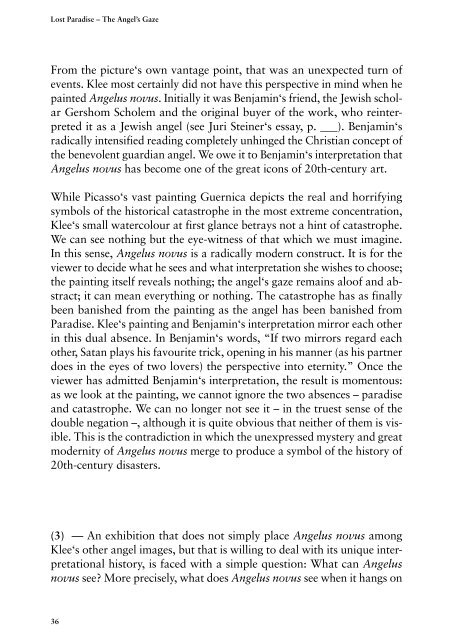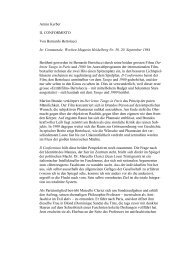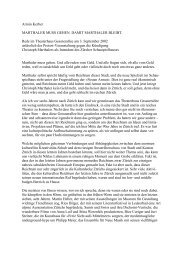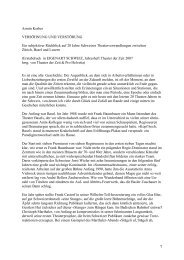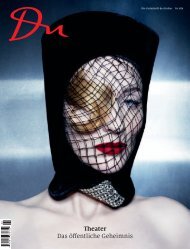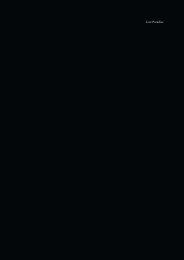Create successful ePaper yourself
Turn your PDF publications into a flip-book with our unique Google optimized e-Paper software.
<strong>Lost</strong> <strong>Paradise</strong> – The Angel’s Gaze<br />
From the picture‘s own vantage point, that was an unexpected turn of<br />
events. Klee most certainly did not have this perspective in mind when he<br />
painted Angelus novus. Initially it was Benjamin‘s friend, the Jewish scholar<br />
Gershom Scholem and the original buyer of the work, who reinterpreted<br />
it as a Jewish angel (see Juri Steiner‘s essay, p. ___). Benjamin‘s<br />
radically intensified reading completely unhinged the Christian concept of<br />
the benevolent guardian angel. We owe it to Benjamin‘s interpretation that<br />
Angelus novus has become one of the great icons of 20th-century art.<br />
While Picasso‘s vast painting Guernica depicts the real and horrifying<br />
symbols of the historical catastrophe in the most extreme concentration,<br />
Klee‘s small watercolour at first glance betrays not a hint of catastrophe.<br />
We can see nothing but the eye-witness of that which we must imagine.<br />
In this sense, Angelus novus is a radically modern construct. It is for the<br />
viewer to decide what he sees and what interpretation she wishes to choose;<br />
the painting itself reveals nothing; the angel‘s gaze remains aloof and abstract;<br />
it can mean everything or nothing. The catastrophe has as finally<br />
been banished from the painting as the angel has been banished from<br />
<strong>Paradise</strong>. Klee‘s painting and Benjamin‘s interpretation mirror each other<br />
in this dual absence. In Benjamin‘s words, “If two mirrors regard each<br />
other, Satan plays his favourite trick, opening in his manner (as his partner<br />
does in the eyes of two lovers) the perspective into eternity.” Once the<br />
viewer has admitted Benjamin‘s interpretation, the result is momentous:<br />
as we look at the painting, we cannot ignore the two absences – paradise<br />
and catastrophe. We can no longer not see it – in the truest sense of the<br />
double negation –, although it is quite obvious that neither of them is visible.<br />
This is the contradiction in which the unexpressed mystery and great<br />
modernity of Angelus novus merge to produce a symbol of the history of<br />
20th-century disasters.<br />
(3) — An exhibition that does not simply place Angelus novus among<br />
Klee‘s other angel images, but that is willing to deal with its unique interpretational<br />
history, is faced with a simple question: What can Angelus<br />
novus see? More precisely, what does Angelus novus see when it hangs on<br />
36


